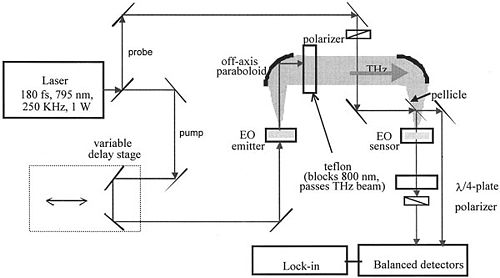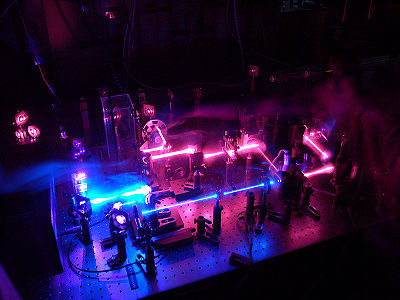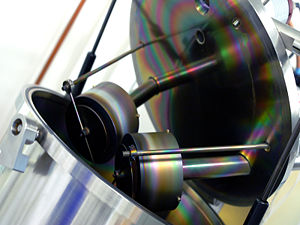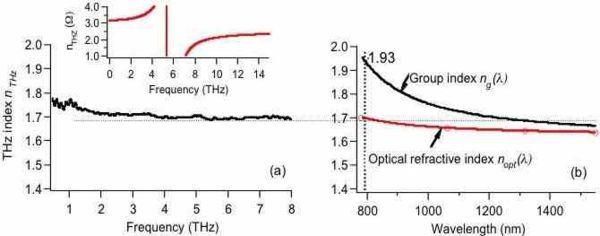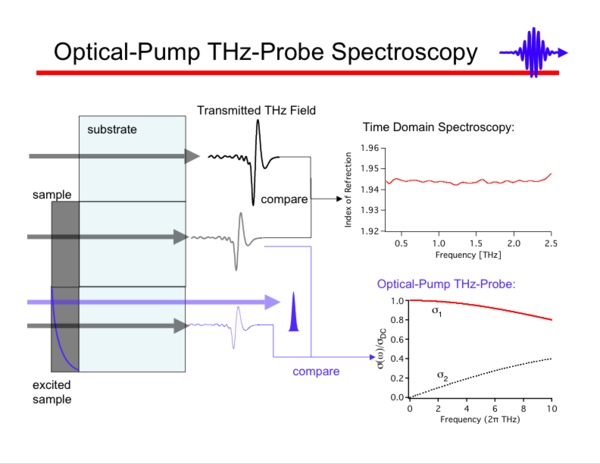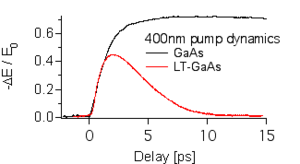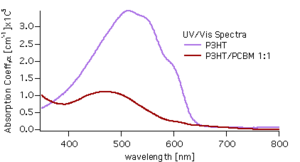Difference between revisions of "Terahertz Radiation"
Cmditradmin (talk | contribs) |
(edited introduction and added history section) |
||
| Line 8: | Line 8: | ||
[[Image: SURA_EMS_chart_full.jpg|thumb|300px|1 THz ~ | [[Image: SURA_EMS_chart_full.jpg|thumb|300px|1 THz ~ 300 µm wavelength ~33 wave numbers ~ 4 meV- Courtesy of www.SURA.org]] | ||
THz is Far-Infrared radiation located between microwaves and infrared in the electromagnetic spectrum. It is | Terahertz (THz) is Far-Infrared radiation located between microwaves and infrared in the electromagnetic spectrum. It is low-energy, non-ionizing radiation which can penetrate many non-polar, non-conducting materials such as clothing, paper, masonry or plastic. Possible applications of THz include: | ||
*Medical imaging - can penetrate several millimeters into tissues with low water content, or deep into teeth, without damage. | *Medical imaging - THz can penetrate several millimeters into tissues with low water content, or deep into teeth, without damage. For example: THz can be used for burn depth assessment, skin cancer identification, etc. | ||
*Security screening- | *Security screening- THz can penetrate clothing and reveal hidden weapons. Explosives, biological agents, and controlled substances have specific spectral signatures allowing for chemical identification. | ||
*Spectroscopy- THz time domain spectroscopy can | *Spectroscopy- THz time domain spectroscopy can measure the low-energy, far-infrared properties of substances that are opaque in the visible and near-infrared regions of the spectrum. In particular, collective vibrations, phonon resonances, and scattering rates of charge carriers are typically in the THz range. | ||
*Manufacturing- | *Manufacturing- Circuit boards, device components, and the contents of paper packages can be easily visualized for quality control. For example, THz inspections can identify voids in space shuttle foam, like those responsible for the Columbia disaster. | ||
<br clear='all'> | <br clear='all'> | ||
===History of THz Science=== | |||
Far-infrared studies have occurred since the invention of the bolometer in 1881 by astronomer Samuel Langley. Much of the early far-infrared work was done by Rubens, who discovered reststrahlen sources enabling measurements crucial to Planck's blackbody radiation theory. Far-infrared transmission studies of superconductors confirmed the energy gap predicted by Bardeen,Cooper, and Schrieffer's superconductivity theory. Since the invention of frequency-division multiplexing in 1949, Fourier-transform infrared spectroscopy became a standard tool in physical chemistry. Over the years, numerous sources and detectors have been discovered e.g. Golay cell, water-vapor laser, pyroelectric detector, synchrotrons, free-electron lasers, and quantum cascade lasers. | |||
Modern pulsed-THz sources grew out of the work of Auston, Nuss, and Grischkowsky on photoconductive switches, electrical pulses on transmission lines, and far-infrared emission from nonlinear crystals in the 1980s. Since their pioneering work, photoconductive switches have become one of two popular methods of generation and coherent detection of bright THz pulses with high sensitivity. The other popular modern method involves generation of broadband THz radiation via "optical rectification" and coherent detection of the THz waveform through free-space electro-optic sampling, both occurring in nonlinear optical media. | |||
<br clear='all'> | |||
=== THz generation === | === THz generation === | ||
[[Image:Experimental_setup.jpg|thumb|500px|Experimental setup- source. Polymer Sci. B. Polymer Phys- will redraw]] | [[Image:Experimental_setup.jpg|thumb|500px|Experimental setup- source. Polymer Sci. B. Polymer Phys- will redraw]] | ||
Revision as of 18:17, 23 September 2009
| Previous Topic | Return to Second-order Processes, Materials & Characterization Menu | Next Topic |
Terahertz (THz) is Far-Infrared radiation located between microwaves and infrared in the electromagnetic spectrum. It is low-energy, non-ionizing radiation which can penetrate many non-polar, non-conducting materials such as clothing, paper, masonry or plastic. Possible applications of THz include:
- Medical imaging - THz can penetrate several millimeters into tissues with low water content, or deep into teeth, without damage. For example: THz can be used for burn depth assessment, skin cancer identification, etc.
- Security screening- THz can penetrate clothing and reveal hidden weapons. Explosives, biological agents, and controlled substances have specific spectral signatures allowing for chemical identification.
- Spectroscopy- THz time domain spectroscopy can measure the low-energy, far-infrared properties of substances that are opaque in the visible and near-infrared regions of the spectrum. In particular, collective vibrations, phonon resonances, and scattering rates of charge carriers are typically in the THz range.
- Manufacturing- Circuit boards, device components, and the contents of paper packages can be easily visualized for quality control. For example, THz inspections can identify voids in space shuttle foam, like those responsible for the Columbia disaster.
History of THz Science
Far-infrared studies have occurred since the invention of the bolometer in 1881 by astronomer Samuel Langley. Much of the early far-infrared work was done by Rubens, who discovered reststrahlen sources enabling measurements crucial to Planck's blackbody radiation theory. Far-infrared transmission studies of superconductors confirmed the energy gap predicted by Bardeen,Cooper, and Schrieffer's superconductivity theory. Since the invention of frequency-division multiplexing in 1949, Fourier-transform infrared spectroscopy became a standard tool in physical chemistry. Over the years, numerous sources and detectors have been discovered e.g. Golay cell, water-vapor laser, pyroelectric detector, synchrotrons, free-electron lasers, and quantum cascade lasers.
Modern pulsed-THz sources grew out of the work of Auston, Nuss, and Grischkowsky on photoconductive switches, electrical pulses on transmission lines, and far-infrared emission from nonlinear crystals in the 1980s. Since their pioneering work, photoconductive switches have become one of two popular methods of generation and coherent detection of bright THz pulses with high sensitivity. The other popular modern method involves generation of broadband THz radiation via "optical rectification" and coherent detection of the THz waveform through free-space electro-optic sampling, both occurring in nonlinear optical media.
THz generation
THz radiation is typically generated via optical rectification (OR) in a nonlinear optical (NLO) material or impulsively from photoconductive dipole antennae. Finite carrier lifetime limits the bandwidth available from photoconductive materials to less than that acheivable via difference frequency mixing (i.e. OR) in NLO materials.
In a non linear material the polarization will not reverse its sign at the same time as the driving field. If the field is applied with a femptosecond laser with a large spectral bandwidth, the mixing of different frequencies results in electromagnetic waves in the terahertz region. This depends on the second order susceptibility of the medium.
In a typical experimental setup a 180 fs pump laser is directed on an EO emitter which generates THz by optical rectification. The radiation induces a change in the EO material in the sensor via the electrooptic effect. A probe beam is passed through the sensor and then compared to a paired reference beam using a photodetector.
See Sum and Difference Frequency Generation
EO Polymers for THz
EO poled polymers have the potential to acheive orders of magnitude higher optical nonlinearities than crystalline materials. Poled polymers have acheived electro-optic coefficients >400 pm/V, which is two orders of magnitude larger than the inorganic crystal ZnTe, which is a standard material for THz generation.
Phase matching (i.e. velocity matching) is necessary for efficient THz generation. Due to phonon lattice resonances in the THz regime, NLO crystals can be quite dispersive. Many crystals are also disperive in the visible and near infrared (NIR). Polymers have very low dispersion. Their NIR and THz indeces of refraction are nearly the same, yielding very good phase matching.
See Sinyukov, Hayden [1]
See Hayden 2003 [2]
Spectroscopy Applications
When THz radiation passes through an object its dielectric properties can be revealed.
THz Time Domain Spectroscopy
The electric field of the THz pulse is sampled via the electrooptic effect in a second order nonlinear material.
The field transmitted through the sample is compared to that transmitted through its substrate (or through free space for free standing samples) and through fourier analysis the frequency dependent index of refraction and absorption coefficients are extracted.
Optical Pump THz Probe Spectroscopy
In Optical Pump THz Probe Spectroscopy (OPTP) the THz waveform transmitted through the excited sample is compared to that transmitted through the unexcited sample and through fourier analysis the full frequency dependent complex conductivity can be obtained. Modeling on this photo-induced conductivity yields the mobility and carrier density, also giving the photon-to-carrier yield. Control of the delay between the excitation (the "pump") and the THz pulse (the "probe") provides the time evolution of the photoexcited state.
To extract the complex conductivity we use the following approximate analytic relationship following the work of Sundstrum
- <math>\tilde{\sigma} (\omega) \approx - \frac {(n_{THz} +1 )}{Z_0d}\frac {\Delta \tilde{E}(\omega)}{\tilde{E}_0(\omega)}\,\!</math>
where
- <math>d\,\!</math> is the absorption depth at λexc
Advantages
- Non-contact low energy (meV) non-perturbing optical probe with sub-ps resolution
- Coherent detection provides magnitude and phase of THz waveform, i.e. direct access to the complex dielectric properties of materials under study
- THz radiation is sensitive to charge carriers as carrier scattering times are fs-ps placing the scattering (damping) rate in the THz regime
Special Studies
Time-resolved broadband THz studies have the capability to reveal new physics concerning the nature of charge transport in polymers. Many models of conductivity are similar over narrow bandwidths, particularly 0-2 THz (Figure 1.26, left). Broadband (0-15 THz) OPTP will access frequency ranges where the models diverge from each other allowing a more complete understanding of the fundamental charge carrier dynamics and mechanisms.
Carrier Dynamics
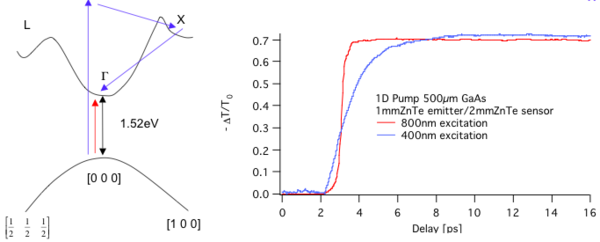
OPTP spectroscopy has be used to examine carrier dynamics, Drude-like and deviations from the Drude model in popular semiconductors such as semi-insulating (SI-) GaAs
Carrier trapping
It can also be used to identify carrier trapping. The rapid decrease in THz absorption (below) in photoexcited LT-GaAs is due to carrier trapping by As clusters.
We have applied this technique to study carrier dynamics in RR-P3HT and ultrafast charge transfer in the bulk heterojunction P3HT/PCBM 1:1 excited with either 400 nm (3.1 eV) and 800 nm (1.44 eV) light, the results of which are published in J Phys Chem C.
At low temperature there is an increase in the photoconductivity (mobility) of P3HT due to decreased torsoinal disorder which increases the effective conjugation length. The faster recombination dynamics are associated with inhibited interchain hopping at low temperature.
The extracted complex frequency-dependent conductivty of P3HT exibits characteristics of strong (Anderson) carrier localization and inhibited long range trasport due to disorder (below). Fitting of the conductivity to the Drude-Smith model provides photon-to-carrier yields of < 1.5% and a hole mobility of ~35 cm^2/Vs. The THz regime mobility agrees well with published DFT calculations of the predicted intrinsic hole mobility in well ordered P3HT.
The high frequency THz radiation probes carriers over short (nanoscale) distances, which corresponds to highly ordered domains in this system. Through this experiment we are able to experimentally determine the upper limit of the carrier mobility that would be seen in a device with perfect ordering, instead of the disorder limited mobility typically seen in devices.
External Links
See Wikipedia Terahertz Radiation
See Wikipedia Terahertz time-domain spectroscopy
See Wapedia Terahertz
See THz Group Wiki- password required THz Polymers Wiki
References
- ↑ 2003 Efficient Electrooptic Polymers for THz Applications J. Phys. Chem. B 2004, 108, 8515-8522
- ↑ L.M. Hayden, A. Sinyukov, M. Leahy, P. Lindahl, J. French, W. Herman, M. He, R. Twieg, "New Materials for Optical Rectification and Electro-optic Sampling of Ultra-short Pulses in the THz Regime," J. Polymer Sci. B. Polymer Phys., Vol 41, 2492 -2500 (2003)
| Previous Topic | Return to Second-order Processes, Materials & Characterization Menu | Next Topic |
